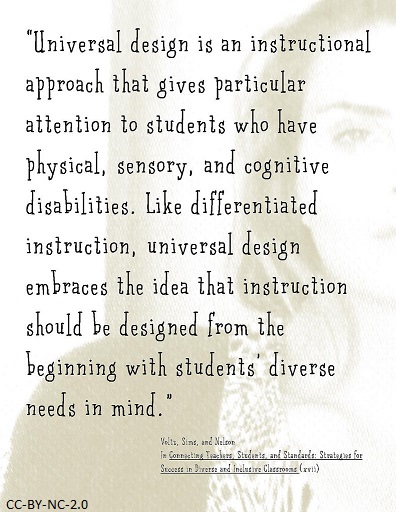The CAST website is a gateway to principles, tools and resources for educators.
See how UDL guides the design of instructional goals, assessments, methods, and materials that can be customized and adjusted to meet individual needs.
UDL Instructional Module
If you are new to UDL, please go to the IRIS module on UDL and complete the module readings and multimedia presentations. As you read, watch and listen to the IRIS module, notice how IRIS has implemented the principles of UDL in their module design.
The IRIS Center. (2009). Universal Design for Learning: Creating a Learning Environment that Challenges and Engages All Students. Retrieved from https://iris.peabody.vanderbilt.edu/udl/
Module goals:
- Understand the principles of Universal Design for Learning (UDL)
- Be able to apply the Universal Design for Learning principles to the components of a curriculum
Myths and Misconceptions about UDL
UDL is only for learners with disabilities.
UDL aims to remove barriers to learning and supports inclusive institutional and teaching practices that reach all learners. As many post-secondary institutions must support large student populations and students usually participate in large class sizes, UDL practices ensure that a large, diverse student body still has access to learning in ways that support their individual needs. Therefore, instructors still need to consider using UDL in their pedagogy, even if they do not have learners with disabilities in their courses. It is important to remember that those students who vary in age, gender, cultural background, first language and abilities will also benefit from UDL
Incorporating UDL into pedagogy lowers academic rigor.
UDL does not replace regular program, course and assessment objectives. UDL practices simply support the use of multiple means of representation, multiple means of action and expression and multiple means of engagement to support all learners in meeting these objectives. It may be argued that academic rigour increases, as students are expected to express materials in multiple ways, limiting options for memorization and increasing the likelihood of deep learning.
UDL has no research behind it.
UDL research has been conducted in many fields, by varying researchers with the support of numerous institutions. Its framework resulted from thorough research in the fields of cognitive science, cognitive neuroscience, neuropsychology and neuroscience. UDL guidelines and practices were a direct result of intensive research and investigation both supported by experimental and quantitative evidence as well as scholarly reviews and expert opinions. A compilation of the past 10 years of UDL research can be located on the CAST website.
To make UDL work, you have to use technology.
It is true that technology can effectively support learning in today’s classroom and can play an important role in the implementation of UDL. However, in order to support UDL and apply it effectively, technology is not a requirement if it is not available. . Instructors can still support student learning with no-tech or low-tech options as UDL classrooms focus on flexible learning methods to support learning not just technological ones. The following resources provide some low/no tech UDL classroom options:
1. Example of a Technology-less lesson by Rose, Gravel, & Domings (2010)
2. Technology-less options according to UDL principles by Prince George County Public Schools
UDL is just good teaching.
UDL does not automatically assume or result in good teaching. The term “good” is often judged subjectively and therefore not an ideal term for academic discussion. UDL principles, guidelines and checkpoints provide a clear framework that informs intentional teaching practices. Effective teaching will support opportunities for BOTH instructors and students to assess learning meaningfully and frequently in an inclusive physical and intellectual environment. However, unless an instructor is referencing the UDL framework and applying the UDL principles in order to make decisions, assess and/or inform, they are not implementing UDL.
Watch this video from The National Center on Universal Design for Learning (now merged with CAST). A panel of experts discusses the UDL practices from a first grade mathematics lesson.
National Center on Universal Design for Leanring]. (2010, Mar. 17). UDL Guidelines in Practice:Grade 1 Mathematics. [Video File


